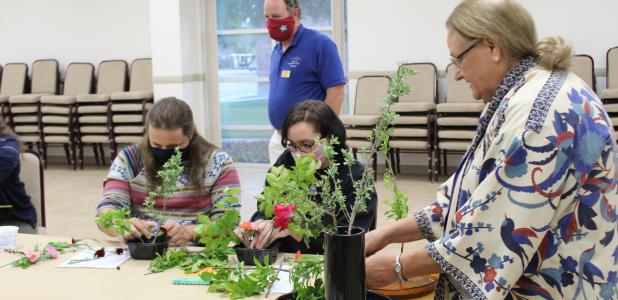Copperas Cove locals learn about Ikebana floral design
By BRITTANY FHOLER
Cove Leader-Press
Approximately a dozen people recently attended a free class on Japanese flower arranging at the Copperas Cove Public Library.
The class was taught by Joyce Brown, who is a member of the Society for Creative Anachronism (SCA), which is an organization focused on medieval arts and sciences and history.
Ikebana is the Japanese word for arranging flowers, or the direct translation “make flowers alive”. It is believed to have first started in Japan around 500 BCE, and by the 1100s, the art of arranging flowers became more formalized as members of royalty in Japan began decorating their palace with the flower arrangements.
Today, there are over 3,000 schools of Ikebana.
Brown lived in Okinawa, Japan for 15 years, where she studied the Sogetsu school of ikebana for four years.
“I moved to a foreign country because I wanted to go to a foreign country and learn, and so [ikebana] was just another thing,” Brown said. “I studied karate, and [ikebana] was just another aspect of Japanese culture and of course, it’s beautiful.”
Brown said she was never interested in floral arrangement in the United States.
Ikebana is “drastically different from American or European flower arrangement, mainly in its simplicity,” according to Brown. “It’s just less. The objectives are different. The purpose of ikebana is to have a period or time of self-reflection, to sit there quietly, usually in silence…and to reflect on nature or whatever it is you want to reflect on. It is often used in correlation with meditation.”
Brown showed two examples of Ikebana- one in a tall vase and one in a short bowl. The tall vase style is called nageire, while the short bowl is called moribana. The students learned how to create their own arrangement using a small black plastic bowl, following the rules for the moribana style.
Brown taught the No. 3 arrangement which features a tall branch, a shorter branch and the flower.
“The tradition became that the arrangement had three basic lines, and they do in Japanese culture represent Heaven, Man and then the Earth,” Brown said. “This is called shin, soe and hikae.”
The branches and flowers are placed at specific angles to represent shin (heaven), soe (man), and hikae (earth).
Traditionally, one would use a kenzan (flower frog), which is a metal tool used to hold the flowers and branches in place. Brown provided candles for the students to use instead of a kenzan. The students stuck their branches and flower stems into the candle which was set inside the bowl of water.
“The water is supposed to represent any body of water,” Brown said. “The reflection gives you a chance to meditate, think about nature.”
Brown explained that the design features negative space, which she said was just as important as where the flowers are located.
“There are rules, and that’s what I want to show you because the rules help you at first to gain some confidence and to know what you’re doing with something that is so obviously different, but you must remember that you are the creator, and you are the artist, and you can do what you want,” Brown said. “The Ikebana police are not going to come by. When you get done, if you don’t like it, move it a little bit.”
Brown said that the structure of ikebana worked for her and allowed for her to expand and experiment with how her design turned out.
Brown said she was “flabbergasted” eeing how many people came out to the class. She added that she would be interested in teaching a follow up class if people were interested.
Library Director Kevin Marsh was present at the ikebana class.
The library has done classes like this one in previous years, but due to the COVID-19 pandemic, there have not been any for the past year. As gathering restrictions have lightened and more people are getting vaccinated, Marsh said it was time to offer a class again.
He said he was also very pleased with the turnout.
“There’s just so many fascinating little bits of history and craft that can be taught, and you never know what’s going to catch somebody’s interest,” Marsh said. “Multiple different things, trying to offer something for every interest, and partnering with the SCA (Society for Creative Anachronism) Medieval history club allows the library to bring in instructors we wouldn’t otherwise find and offer just a wide range of classes.”
Other classes at the library include the Scribal Guild, which will be meeting at the library at 7 p.m. on April 28, where people will learn calligraphy.
For more information on future library events, visit the library’s website and view the Calendar of events at https://www.copperascovetx.gov/library/.

